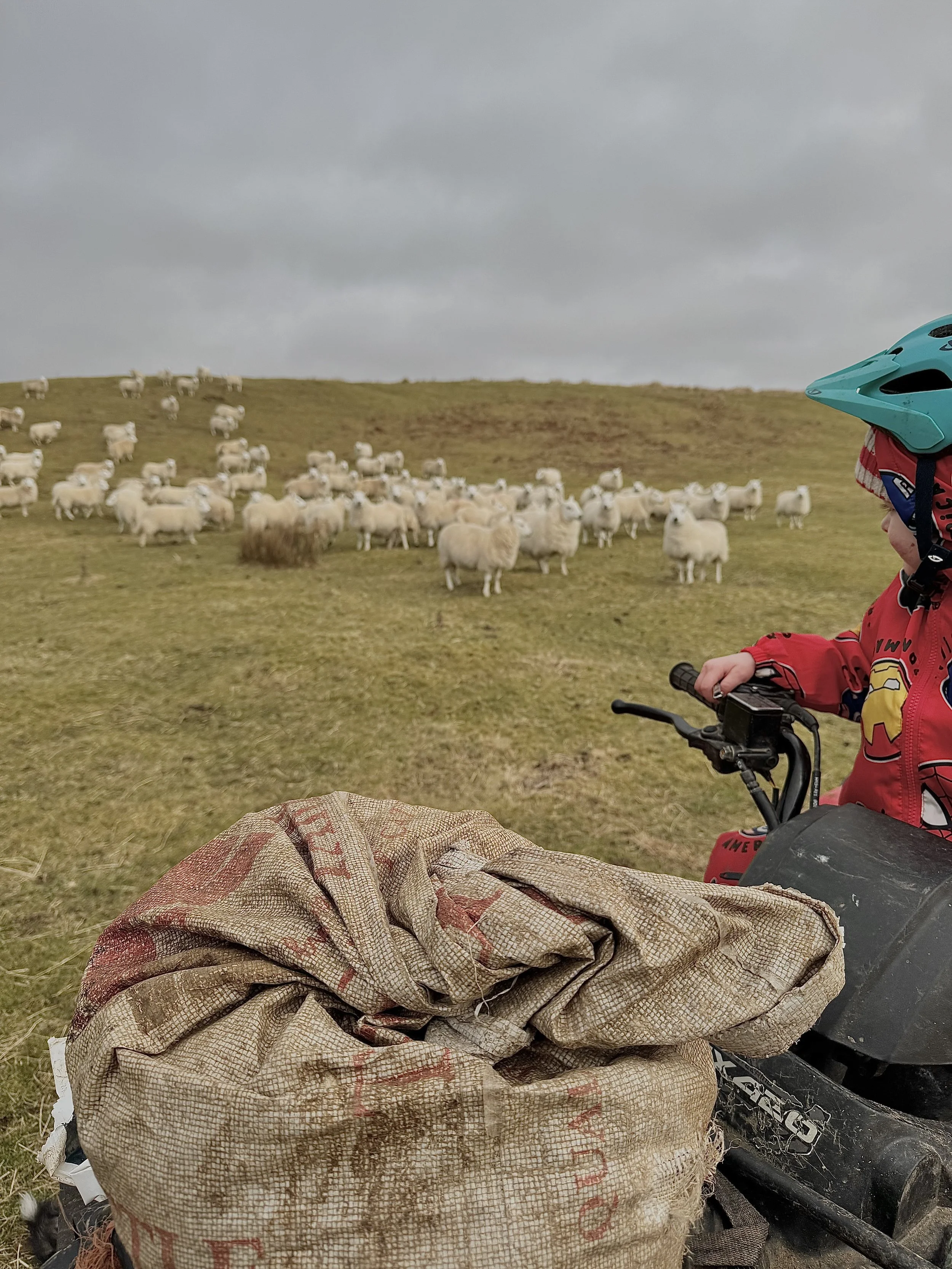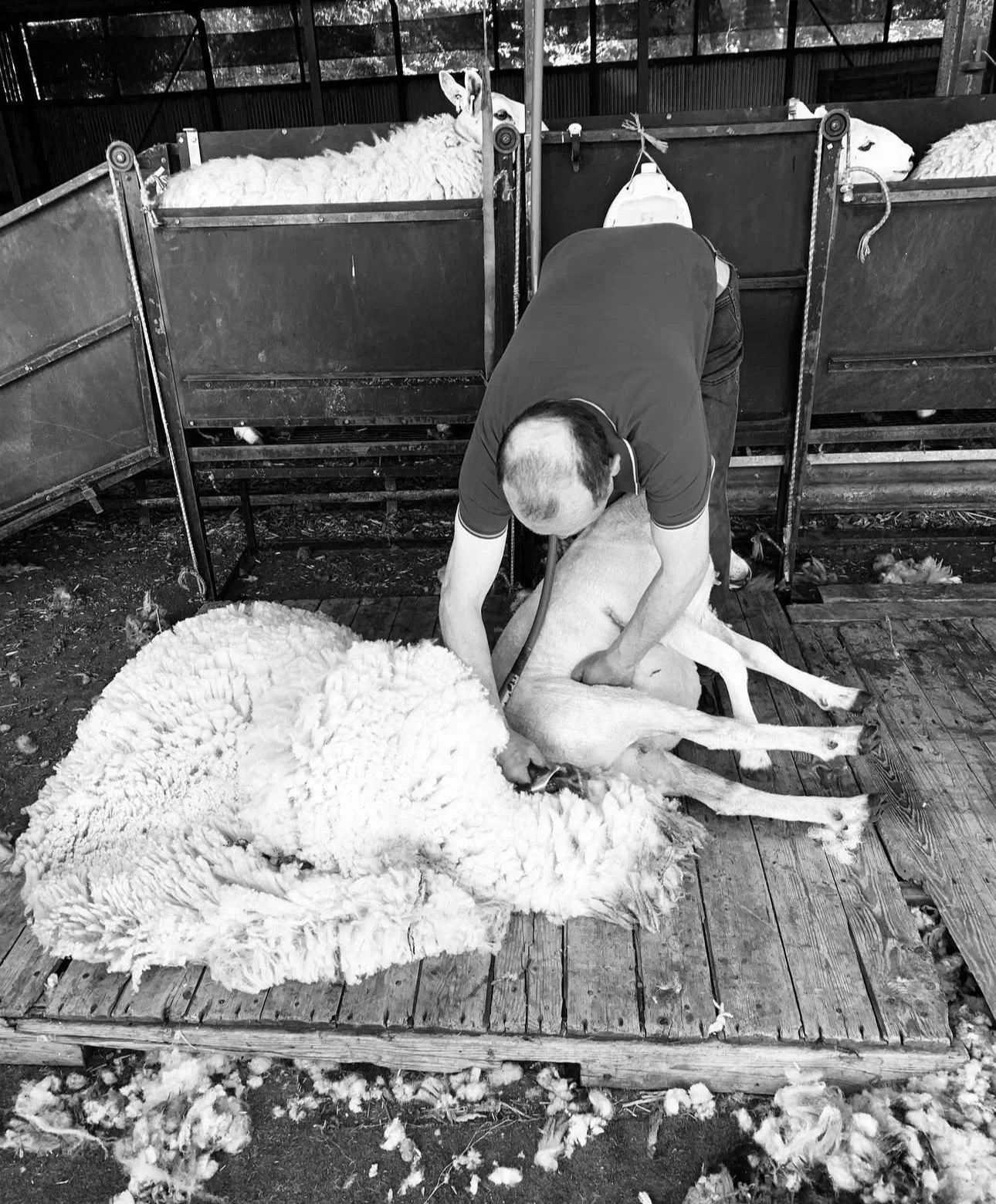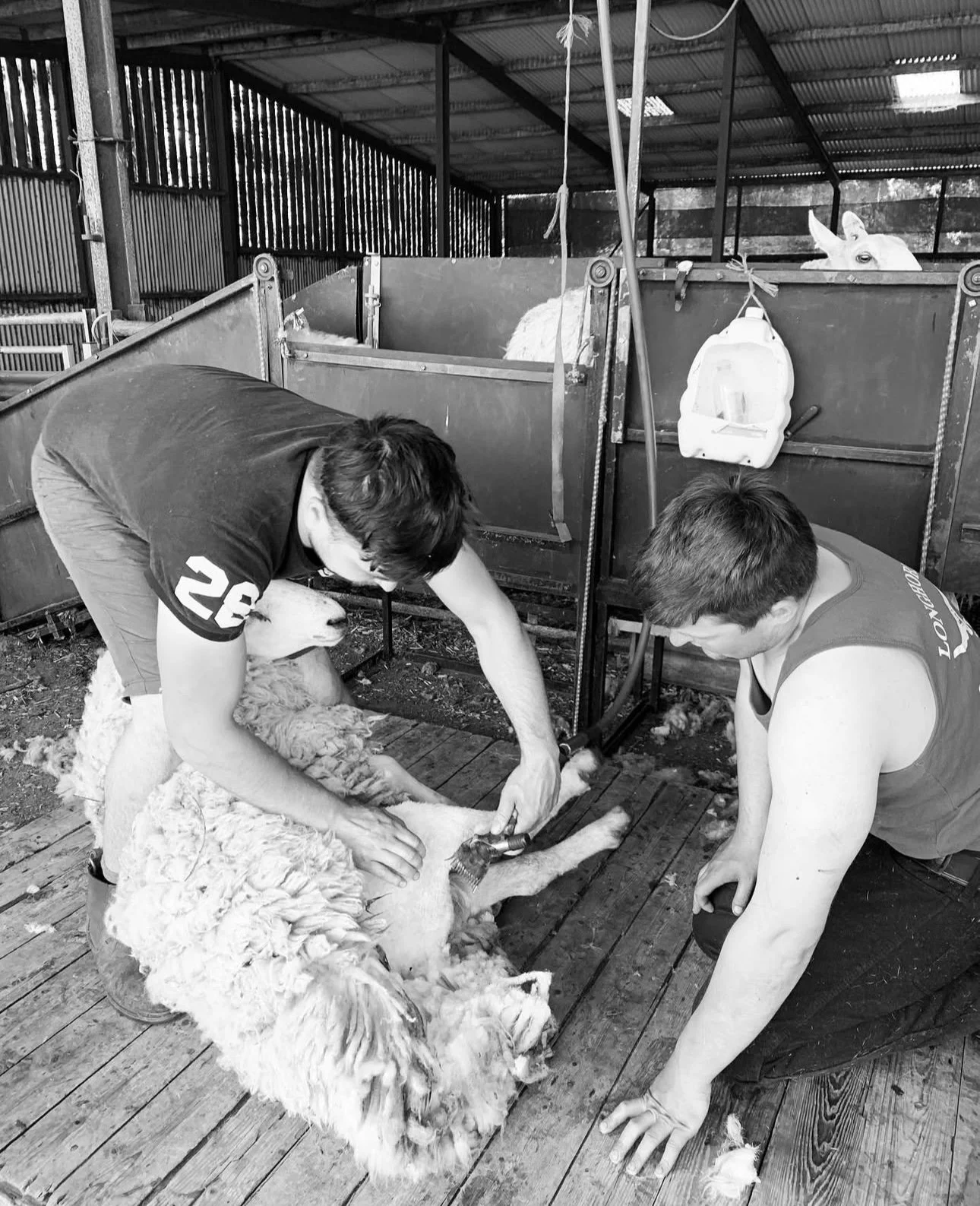From Fleece to Fibre
Why we’re talking wool in July.
This month’s blether is all about the cycle of wool and why I use it…
When you think of wool, your mind probably goes to cosy jumpers, warm scarves, or perhaps a hand knit hat for those blistering winter winds. But for those living and working on farms in the UK, wool begins in the height of summer, not winter.
July should be a hot month. Although, if you’re in Scotland like me, you might be wondering if we had our summer in June because lo and behold it’s raining again! Still, July is a peak time for shearing, and it’s not about fashion or fibre markets. It’s about livestock health, tradition, and the steady rhythm of farm life.
This is the beginning of the wool story — from fleece to fibre — and it starts right here in the height of summer.
Shearing and the Family Farm Cycle
After the intensity of lambing in spring, shearing is the next big moment in the farming year. Removing the fleece allows ewes to stay cool and helps their lambs nurse more easily. It’s also a bonding moment between lamb and mother, and between farmer and flock. For me, it’s a reminder of the legacy we’re carrying forward as a family.
Magnus, Axel and Rosie with our bale of raw fleeces to be sent to British wool depot.
Just like lambing, shearing is a full family affair. My journey ties into this long cycle through marriage to my husband, Neil. I now live at Woodburn, Hawick, where his father, Syd, grew up alongside his parents, Bill and Madge, who started this whole farming legacy.
Together, the family farms — Woodburn, Parkhill, Easter Alemoor, Borthwick Brae, and Mains — totalling around 3,000 acres across the rolling hills surrounding Hawick. Hills that have supported generations of sheep and shepherds alike. This is why Neil is drafted in to help during busy seasons, and I, when necessary.
It’s in these hills, among these flocks, that the journey from fleece to fibre quietly begins — long before it reaches a mill or knitting needle.
Why We Shear in Summer. It’s more than a haircut; it’s essential for sheep welfare.
I finally made it to the hairdresser this week, months overdue. I’d planned to go back in spring, but (coincidentally) lambing season took over, and let’s say hair appointments don’t 'make the cut' when you’re knee-deep in mucking out and caring for ewes with their lambs.
Because while I can delay a haircut, they don’t have that luxury.
Sheep can’t take off their wool when it gets too warm, remember Sheila the sheep lost for 6 years and 21kg of wool!! If we as farmers don’t shear them before the heat of summer, it’s not just uncomfortable for them; It can be dangerous.
Here’s why:
• Overheating: A full fleece acts like a winter coat. In the warmer months, it can cause sheep to overheat and suffer from heat stress.
• Flystrike: This is a big one. If wool gets damp or dirty, it attracts blowflies, which lay eggs that hatch into maggots. It’s as awful as it sounds—painful, distressing, and even fatal if not caught in time.
• Wool blindness: Some breeds, particularly the merino sheep, which I think Sheila was, grow fleece that covers their eyes, making it hard to see. This can affect their ability to graze and stay safe.
That’s why we shear in summer. It’s not about style or show, it’s about keeping our flock healthy, comfortable, and protected.
So while I might have waited too long for a cut, our sheep will not. Their well-being depends on it.
Across the UK, there are more than 60 recognised sheep breeds, each with its unique fleece — different fibre lengths, textures, and qualities. I’m working on something super exciting to showcase this all soon! But regardless of the breed, shearing is essential for sheep welfare.
Sheep don’t naturally shed their fleece, which means it’s naturally renewable. If they’re not shorn regularly, their wool just keeps growing—and not in a good way. Over time, it becomes heavy, matted, and dirty, which can lead to some pretty nasty health problems. One of the worst is something called flystrike.
Flystrike happens when blowflies lay eggs in the soiled wool, usually around the tail area. When those eggs hatch, the maggots start feeding on the sheep’s flesh. It is as horrific as it sounds, and if it is not caught early, it can be fatal.
Prevention is key
Luckily, there are ways to prevent this. One common method is 'crutching', which means shearing the wool from around the sheep’s tail and back end to keep things cleaner. Most farmers also use tail docking at infancy, which involves shortening the tail to reduce the area where dirt and moisture can build up. How short the tail is kept can depend on the breed and sometimes on aesthetics, especially when the sheep are being sold for breeding at auction.
Another important tool in the prevention toolkit is using insecticidal treatments like Crovect. This helps protect sheep not only from flystrike, but also from lice and ticks, which can affect their health and comfort too.
Image of Neil gathering some of our flock.
Taking these preventative steps is a key part of good sheep husbandry, and it makes a big difference in keeping the flock healthy and happy.
Shearing is prevention. Shearing is care.
For years, farmers like the Andersons have faced a tough reality: wool often doesn’t fetch a fair price at auction. That’s an understatement! Despite this, farmers across the UK continue to hire professional shearers because keeping their sheep healthy is the priority, not profit. Often, shearing even comes at a financial loss.
But change is in the air. Over the past year, prices for core British wool types—like Cheviot, Medium, and Cheviot Cross—have climbed, now averaging over £1.20 per kilogram. According to British Wool, returns for farmers in 2024 are about 70% higher than in 2023, with typical fleeces earning between £1.15 and £1.35. This is a meaningful step forward for the people and the fibre behind your favourite woollens.
There’s still work to be done to achieve fully sustainable wool pricing, but with growing demand and prices at their highest in six years, the future looks brighter for British wool.
When you choose sustainably sourced wool, you’re supporting more than just fabric; you’re investing in animal welfare, the hard work of local farmers, and a circular, responsible fashion industry that honours nature every step of the way.
The Skill of Shearing.
Shearing is physically demanding and incredibly skilled work. Today, shearers use electric combs, but years ago, it was done with large hand shears. Go back even further, and women would sit and pluck loose fleece from sheep by hand: slow, patient, painstaking work. Can you imagine?
Once the fleece is off, it’s passed to a wool classer — in our case, the ever-careful Granny Gill see image below— who inspects, rolls, and bags it before it heads to a grading depot.
We’re fortunate to have one nearby here in the Scottish Borders, where wool is sorted by quality and directed to its next purpose: yarn, stuffing, or even insulation. It depends on the quality of the fleece. Our pure-breed Cheviot wool is usually destined for bedding due to its lofty nature and pure white coat. There are lots of great options for natural bedding, one of which comes to mind is Floks.
And that’s the moment the transformation begins — from fleece to fibre.
A Glimpse into the Flock.
Here on the Anderson family farm, sheep have been part of our landscape and our lives for generations. Beyond the well-known pure-bred flock of South Country Cheviots, which proudly carry the Alemoor prefix, our hills are home to several carefully managed flocks.
They maintain closed flocks of Blackface ewes, Bluefaced Leicesters, a handful of Suffolks, and Scott has branched into Texels with his wife Katy. The majority of breeding is done in-house, which is a testament to the health and resilience of the Anderson flocks.
The Spark That Lives On
In recent years, my husband Neil and I have been building up a flock of pure-bred South Country Cheviots of our own under the Woodburnhaugh prefix; What started as a handful of carefully selected ewes has grown into a bloodline we’re proud to call our own — bred with the same care, attention to detail, and deep respect for the land and livestock that has always defined our family name.
As we’ve slowly built up our flock, we’ve had the privilege of learning from every generation of the family. Neil, a knowledgeable and skilled stockman in his own right, especially benefited from the quiet wisdom and patience of his Papa Bill. No question was ever too silly, and Bill was always generous with his knowledge. It means so much to now live and work at Woodburn, where it all began for Neil’s grandparents, Bill and Madge.




That spirit of shared knowledge continues today. Though Neil’s experience runs deep to his roots, he remains humble and always eager to learn; often asking questions of his dad and brothers, Ross and Scott. When I first met Syd, he said to me, “Do you always ask as many questions?” That makes me laugh to this day! I have always been eager to learn and understand their livelihood. I don’t think I quite knew then that, 16 years later, I’d have my sustainable knitwear brand, let alone my flock and be growing it too. I especially love the black Cheviots and was delighted to have a black tup born in this year’s lambing. Their advice and willingness to share help us all improve, and they are very much part of what makes the flock what it is.
“The South Country Cheviot is a breed full of character, and the sheep have a real spark about them, which is what I love to see in any breed.” Syd, my father-in-law. Source: Scottish Farmer 2019
That spark, that vitality, is what we’re preserving when we shear. It’s not just wool off a sheep’s back — it’s care, legacy, and preparation for the seasons ahead.
Why I Choose Wool for Loops of Colour: Sustainability & Circular Economy
At Loops of Colour, my passion is creating beautiful, durable, and sustainable products that honour the land and animals that produce them. Wool isn’t just a natural fibre — it’s a cornerstone of sustainable fashion and the circular economy.
• Renewable & biodegradable: Wool grows back every year, making it a renewable resource. When your wool garment reaches the end of its life, it decomposes naturally, giving back to the land it grazed, unlike synthetic fibres that linger in landfills for centuries.
• Low impact & local: By sourcing my wool from local mills, I reduce transport emissions, support regional economies, and ensure greater transparency in the process. I would love to start working on the process of taking our fleeces into yarn and creating a special collection purely from my flock. It’s a long journey — one I’m still in the midst of navigating, but deeply committed to exploring.
• Durability & longevity: Wool fibres are resilient, naturally flame resistant, breathable, and insulating. Clothes made from wool last longer, meaning fewer resources are spent replacing fast fashion items.
• Circular potential: Wool can be recycled, respun, and repurposed. When paired with thoughtful design and care, wool products contribute to a circular economy where waste is minimised and materials continuously flow back into the system.
Using wool from farms where animal welfare is prioritised is the first step towards creating a truly sustainable supply chain.
This is why all the wool I use is dyed with GOTS-certified dyes, which are environmentally friendly, so the water used during the dyeing processes can be cleaned and returned to the water source once dyeing is complete. It’s a fibre with a story — from the July shearing to my knitting needles — and every loop of colour carries that story forward.
That’s why I created the Parkhill beanie a piece that begins with summer shearing and ends as something warm and lasting, made from wool sourced and dyed with care. Every step from Fleece to finished knit, is considered and intentional.
Wool That Tells a Story
So next time you pick up a cone of wool, or a finished product produced by me or another artisan, remember this:
It started under the July sun.
It was part of a cycle that puts animal care before profit.
Where every fleece tells a story of place, weather, hands, tools, and tradition.
From spirited Cheviots to carefully bred Mules, every sheep here is part of a larger picture — one that stretches back generations and still beats strong today.
The Parkhill Beanie is one such piece — inspired by the rolling hills surrounding the studio and the rhythms of life on the family farm. The Woodburn Beanie, named for the very place where our story continues, carries that same spirit. Each loop reflects the land, the legacy, and the care that begins with summer shearing and flows through every Loops of Colour creation.
When you choose woollen accessories from Loops of Colour, you’re not just buying any old wool hat — you’re joining a circle of care, craft, and sustainability.
Thank you for being part of this journey, where every loop carries a legacy.
With love and loops,







